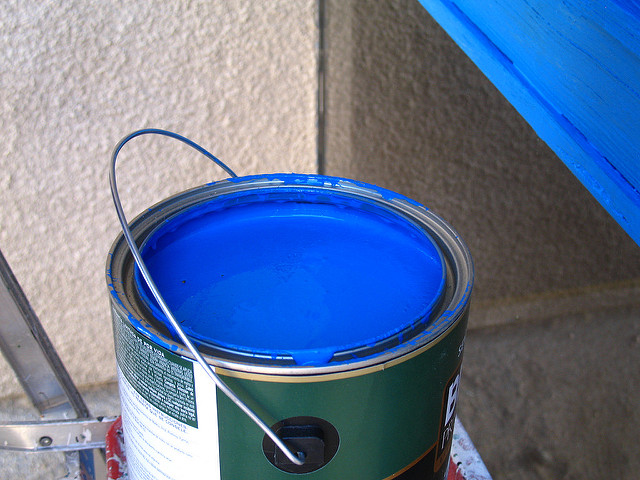Many people love the scent of fresh paint, but few stop to think about where that scent comes from. As it turns out, that new paint smell is largely caused by what’s called, “volatile organic compounds,” or VOCs. VOCs are chemicals that evaporate quickly when left at room temperature. You’ll find VOCs in alkyd oil and latex paints. They help make the paint easier to spread and more durable. But while VOCs can have positive effects on the quality of the paint, they can have very negative effects on people’s health. Low-level exposure to these chemicals can cause headaches, nausea and dizziness, and high-level exposure can have much more dire consequences like permanent kidney and liver damage, as well as problems in one’s respiratory and nervous systems. (Image Source)
Luckily, you can reduce the danger of VOCs by opting to use low-VOC or no-VOC paints instead of regular paint. It’s an easy fix and it costs about the same as buying regular paint. Below are some facts about low-VOC paint and the many benefits that it can offer.
Why Use Low-VOC Paint?
According to recent EPA studies, indoor air tends to be on average about 3 to 5 times more toxic than outdoor air. This is largely caused by the toxic emissions that come from paint and finishes. The most immediately perceivable reason to use low-VOC paint is that it has much less of an impact on the room’s air quality than paints with higher VOC content. You can tell because there’s less of an odor. For buildings that need to maintain good air quality (i.e. hospitals, schools, workplaces, etc.) low-VOC paints are a must.
Using low-VOC paint also helps to reduce allergy-causing toxins, so that people in your family or workplace with susceptible allergies will have a much easier time. Low-VOC paints help to reduce the concentration of contaminants in the ozone layer as well as in groundwater and landfills. Low-VOC paints can also be more easily cleaned up using soap and water. (Image Source)
While the move towards less toxic paint products is not complete, it’s come a long way in recent years. As advances in paint technology have improved, there has been more development of environmentally friendly products with higher performance levels and competitive costs.
What are the Costs? What are the Savings?
Low-VOC paints tend to be about as expensive as a manufacturer’s premium line of regular paints, which is typically somewhere around $30 per gallon. Low-VOC paint is usually high-performance, though, and in many ways it is worth the price tag. Consider, for one, that when purchasing cheaper paint, you might have to repaint after a few years. High-performance paint, on the other hand, might mean painting only once every 10 or even 20 years, which ends up costing you a lot less in the end. You can consider the extra expense of purchasing high-performance, low-VOC paint as an investment that will pay off in time and money saved.
A Few More Things to Consider
Check Labels when Buying
It can be a little difficult to determine the right kind of paint to buy due to the way low-VOC paints are labeled and marketed. Do not be confused by paint cans labeled “Low-Odor.” Fumes from VOCs can be masked to create low-odor paint, but it doesn’t mean they can’t still be harmful to you and the environment simply because you can’t smell them.
Also, there are certain low-VOC paints that are labeled as “Green Seal” certified. This does not, however, necessarily make them better than other low-VOC paints, as there are low-VOC paints that meet certain LEED standards set by the U.S. Green Building Council, which means they don’t need to obtain Green Seal certification, so either kind works.
All Low-VOC Paints are NOT Equal
A paint can that has a low-VOC label contains paint that has met the EPA’s maximum VOC emissions standards. These, however, differ depending on the paint. Latex paint has to have less than 250 grams of VOCs per liter, while alkyds are allowed to contain 380 grams of VOCs per liter. Preferably, look for paints that contain 150 grams of VOCs per liter or less. Also, know that pigments and additives like conditioners and mildewcides can also contribute to the toxicity of paint, and these are not counted as VOCs.
What’s Behind EPA Regulations
And finally, it’s important to note that EPA regulations are largely concerned with the reduction of air pollution. There are chemicals, like certain heavy metals, that are not counted as VOCs because they do not increase air pollution, yet they are still toxic.
To Sum it Up
So there is a brief rundown of what VOCs are and the reasons using low-VOC paint is a good way to go. To recap:
– No strong odors during painting, and areas painted can be occupied more quickly.
– The use of low-VOC paint reduces air pollution, ozone depleting chemicals, landfills and groundwater pollution.
– Low-VOC paint performs at high levels in terms of wall coverage and durability, so the slightly higher price tag is generally worth it.
Reference: http://www.mrdspainting.com/blog1/benefits-of-low-voc-paint/

